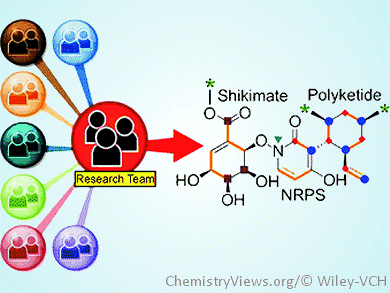A“Crowdsourcing” Approach to Sample Collection
Since the discovery of penicillin, fungi have been a nearly inexhaustible source for the discovery of new drugs. “Crowdsourcing”, the cooperation of a large number of interested nonscientists, has helped to find a new fungus from which American researchers have now isolated and characterized an unusual metabolite with interesting antitumor activity.
To date, fewer than 7 % of the more than 1.5 million species of fungi thought to exist have been investigated for bioactive components. To change this situation, a research group headed by Robert H. Cichewicz at the University of Oklahoma has prepared a collection of several thousand fungal isolates from three regions: arctic Alaska, tropical Hawaii, and subtropical to semiarid Oklahoma. The fungal extracts were analyzed and subjected to biological tests, including antitumor activity, by Susan L. Mooberry at the University of Texas at San Antonio. This resulted in the discovery of a number of interesting substances.
The researchers soon realized that the efforts of a single research team were insufficient to acquire samples representing the immense diversity of the thousands of fungi they hoped to test. Therefore, the team turned to a “crowdsourcing” approach, in which lay people with an interest in science, known as “citizen scientists”, were invited to take part in the collection process by submitting soil samples from their properties. Crowdsourcing is becoming an increasingly important tool, giving research groups access to information and samples that could otherwise not be subjected to scientific study. Crowdsourcing has previously been used in a variety of projects, including the analysis of historic weather data and the classification of newly discovered galaxies.
A Unique Fungal Metabolite with Antitumor Activity
Putting this approach into practice, the research team uncovered a new fungal strain identified as a Tolypocladium species in a crowdsourced soil sample from Alaska. The fungal isolate, which was identified by Andrew Miller at the University of Illinois, was highly responsive to changes in the way it was grown, leading to the production of several new compounds, including a unique metabolite with significant antitumor activity. This substance may represent a valuable new approach to cancer treatment because it avoids certain routes that lead to resistance.
To obtain this substance, a biosynthetic pathway that is not active under normal conditions was activated by the addition of specific chemicals, cultivation in a special medium, and in the presence of Pseudomonas bacteria. The scientists were able to isolate and characterize the metabolite they called maximiscin. Spectroscopic techniques revealed that maximiscin is a rather unusual structure, having been produced through a combination of diverse biosynthetic pathways unique to this fungus.
The researchers point out the essential roles that citizen scientists can play. “Many of the groundbreaking discoveries, theories, and applied research during the last two centuries were made by scientists operating from their own homes. Although much has changed, the idea that citizen scientists can still participate in research is a powerful means for reinvigorating the public’s interest in science and making important discoveries,” says Cichewicz.
- Crowdsourcing Natural Products Discovery to Access Uncharted Dimensions of Fungal Metabolite Diversity,
Lin Du, Andrew J. Robles, Jarrod B. King, Douglas R. Powell, Andrew N. Miller, Susan L. Mooberry, Robert H. Cichewicz,
Angew. Chem. Int. Ed. 2013.
DOI: 10.1002/anie.201306549




